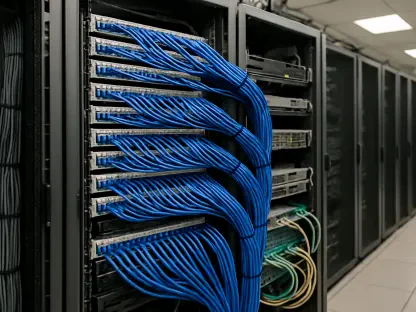Setting the Stage: Why Open RAN Matters in Today’s 5G Landscape
In an era where 5G networks are driving unprecedented demand for connectivity, a staggering statistic emerges: global mobile data traffic is expected to grow by over 25% annually through 2030, fueled by IoT, smart cities, and immersive technologies. Amid this surge, network operators face mounting pressure to build scalable, cost-effective infrastructures capable of handling such exponential growth. Enter Open RAN (ORAN), a disruptive architectural approach that promises to reshape the telecommunications market by breaking down traditional barriers of vendor lock-in and proprietary systems. This market analysis delves into how Open RAN is transforming 5G deployments, offering a lens into its potential to redefine competitive dynamics.
The significance of this analysis lies in understanding how Open RAN’s open, modular framework is not just a technical evolution but a strategic pivot for the industry. By enabling multi-vendor ecosystems and fostering innovation, it addresses critical pain points like high capital expenditure and limited flexibility. This examination will explore current market trends, dissect data-driven insights, and project future trajectories to equip stakeholders with actionable intelligence on navigating the rapidly evolving 5G landscape.
Diving Deep: Market Trends and Data Driving Open RAN Adoption
Current Landscape: Adoption Rates and Key Players
The telecommunications sector is witnessing a notable shift as Open RAN gains traction among major network operators. Recent industry reports indicate that over 20% of global 5G deployments in 2025 incorporate Open RAN elements, a figure projected to climb significantly by 2027. Leading carriers such as Verizon and AT&T have already initiated large-scale trials, leveraging ORAN’s disaggregated architecture to reduce dependency on single-vendor solutions. This trend reflects a broader market push toward cost efficiency, with early adopters reporting operational savings of up to 30% compared to traditional RAN setups.
Beyond individual carriers, collaborative efforts through bodies like the O-RAN Alliance are shaping market dynamics. This consortium, comprising over 300 member organizations, drives standardization of open interfaces, ensuring interoperability across diverse hardware and software components. Such initiatives are lowering entry barriers for smaller vendors, intensifying competition and diversifying the supplier base. However, challenges like integration complexities in multi-vendor environments persist, requiring robust orchestration tools to maintain network reliability.
Economic Impacts: Cost Reductions and Investment Patterns
Economically, Open RAN is altering the financial calculus for 5G network rollouts. By enabling operators to mix and match components—such as Radio Units (RU), Distributed Units (DU), and Centralized Units (CU)—from various providers, capital expenditure is notably reduced. Market analysis suggests that operators adopting Open RAN can save between 25% and 40% on initial deployment costs compared to proprietary systems. This cost advantage is particularly critical in rural markets, where budget constraints often limit coverage expansion.
Investment trends further underscore Open RAN’s growing influence. Venture capital and corporate funding into ORAN-compatible technologies have surged by 35% since 2025, with a focus on software-driven solutions like the RAN Intelligent Controller (RIC). These tools facilitate real-time optimization across disparate systems, addressing interoperability risks. Yet, economic benefits are tempered by regulatory uncertainties in some regions, where spectrum allocation policies and security mandates could impact deployment timelines and costs.
Technological Synergies: 5G Use Cases and Innovation
Technologically, Open RAN aligns seamlessly with 5G’s unique demands, propelling market growth through tailored use cases. In urban centers, its support for high-capacity features like massive MIMO addresses traffic density challenges, ensuring ultra-low latency for applications such as autonomous vehicles. Conversely, in underserved areas, the modular nature of ORAN allows for scalable, cost-effective implementations, bridging digital divides. Industry data highlights that networks leveraging Open RAN for 5G standalone (SA) architectures achieve up to 20% higher efficiency than non-standalone (NSA) setups reliant on 4G cores.
Innovation is another key driver, with artificial intelligence (AI) and machine learning (ML) integration emerging as a transformative trend. AI-powered RICs enable automated fault detection and dynamic resource allocation, critical for managing 5G’s complex data loads. Projections indicate that by 2027, over 60% of Open RAN deployments will incorporate AI-driven optimization, positioning it as a cornerstone of next-generation connectivity. Despite these advancements, market players must navigate potential security misconceptions, as open architectures are sometimes perceived as less secure, though standardized protocols often mitigate such risks.
Looking Ahead: Projections and Strategic Implications
Growth Forecasts: Market Share and Regional Variations
Looking toward the future, Open RAN is poised to capture a substantial share of the 5G market. Analysts predict that by 2030, over 50% of global 5G deployments will utilize Open RAN architectures, driven by its cost and flexibility advantages. Growth will likely vary by region, with North America and Europe leading adoption due to strong regulatory support and established vendor ecosystems. In contrast, emerging markets in Asia and Africa may see slower uptake due to infrastructure constraints, though cost benefits could accelerate penetration in these areas over time.
These projections hinge on continued standardization efforts and technological maturation. The O-RAN Alliance’s role in fostering interoperability will be pivotal, as will advancements in AI and ML integration. Market forecasts also suggest a doubling of vendor diversity by 2028, as smaller players enter the fray, further disrupting traditional hierarchies dominated by legacy providers. This competitive shift could redefine pricing models, benefiting operators but challenging vendors to differentiate through innovation.
Strategic Opportunities: Leveraging Open RAN for Competitive Edge
For stakeholders, Open RAN presents strategic opportunities to gain a competitive edge in the 5G era. Operators can capitalize on multi-vendor flexibility by initiating pilot projects to test interoperability and scalability, particularly for niche 5G applications like network slicing. Collaborating with industry consortia ensures access to cutting-edge standards, mitigating integration risks. Additionally, investing in AI-driven tools offers a pathway to enhance automation, reducing operational overhead while meeting escalating data demands.
Vendors, on the other hand, face a dual imperative: innovate or risk obsolescence. Developing specialized, ORAN-compliant components—whether hardware or software—can secure market share in an increasingly crowded field. Partnerships with operators for co-development of use case-specific solutions could further solidify positioning. Across the board, data suggests that early movers in Open RAN adoption will likely establish long-term dominance, underscoring the urgency of strategic alignment with this transformative trend.
Reflecting on the Journey: Key Takeaways and Future Actions
Looking back, the market analysis of Open RAN reveals a landscape of rapid transformation, where its modular, open architecture has reshaped 5G network economics and technical capabilities. The data paints a clear picture of accelerating adoption, with significant cost savings and innovation driving operator interest. Regional disparities and technological synergies highlight both the opportunities and hurdles that define this shift, while projections underscore a future where Open RAN could become the industry standard.
Moving forward, stakeholders need to prioritize actionable steps to harness this momentum. Operators are encouraged to scale pilot initiatives into full deployments, focusing on AI integration for enhanced efficiency. Vendors must double down on R&D to deliver interoperable, high-performance solutions that stand out in a competitive market. Policymakers, meanwhile, are urged to streamline regulatory frameworks to support secure, widespread adoption. These strategies promise to solidify Open RAN’s role as a bedrock of future connectivity, ensuring the telecommunications sector keeps pace with global demands.









